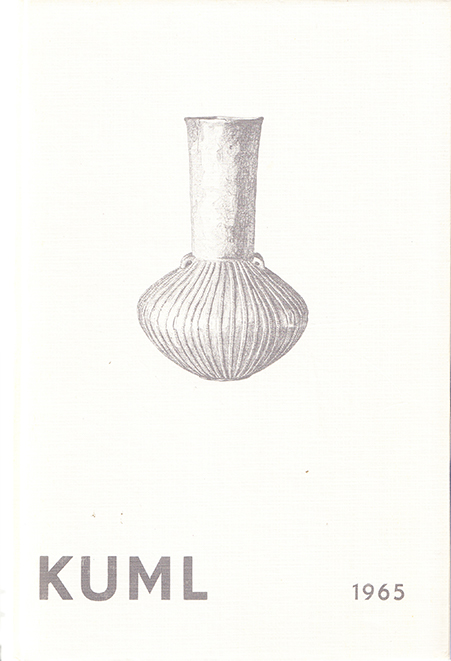Arkæomagnetisme og jernalderslagge
DOI:
https://doi.org/10.7146/kuml.v15i15.104496Nøgleord:
iron age, jernalder, slags, slagge, archaeo magnetism, arkæomagnetismeResumé
Archaeo-Magnetism and Iron-Age Slags
In the first three sections a short review is given of magnetic concepts and their use in archaeomagnetic dating and finding, while in the last section an example on their application is given: Slag pits from prehistoric iron-smelting have earlier (Voss, 1962) been excavated at Drengsted in Southwestern Jutland (fig. 6) and some of them C-14-dated on carbonized straw or charcoal to the age of 210 ± 100 A.D. or to the interval between 320 and 410 A.D. while potsherds and a settlement at the same place indicated an age of the 5th century A.D. Hence it is for the moment doubtful whether the settlement and the iron-smelting are of the same age or not. Planning new excavations in the same area it was then decided, as the slag pits are strongly magnetic to make arealmagnetic measurements as well as paleomagnetic determinations; none of these methods have formerly been applied in Danish archaeological work, wherefore collaboration between Forhistorisk Arkæologisk Institut and Geologisk Institut at the University of Aarhus was started.
The instrument available at the moment was an Askania-Gfz-vertical-intensity-magnetometer, with which an area of 40 X 80 m2 as shown in red in fig. 7 was measured, and to compare the reliability of the method part of the same area was remeasured with a denser net of measuring-points as shown in fig. 8; the mean-error at a point is ± 4 gamma, while most of the positive anomalies lie between 20 and 100 gramma. Afterwards the northern half of the area was excavated and revealed 47 slag pits (fig. 7) 19 of which were undisturbed (full black dots), while the rest were broken up but still lying in their original places, the slags being between 0.6 and 0.9 m in diameter and with weights up to 450 kg. To determine in detail the magnetic anomaly of typical, unbroken slag pits, two small, isolated anomalies were selected in the undisturbed southern part of the area and remeasured detailed, the anomalies of which turned up to be very regular (fig. 9) and in good accordance with the theoretical pattern from a homogeneously magnetized sphere (or short, vertical cylinder) as shown in figs. 11 and 12; a reconstruction of the complete building is shown in fig. 13. Examples of slag pits are shown in figs. 10 and 14.
Apart from the positive magnetic anomalies due to the slags and the negative gradient in the northwestern part of the area due to nearby modem buildings, a positive anomaly of 20 gamma was found over a filled up well at the corner of the small square house in fig. 7, which may be caused by the greater susceptibility of the humus-rich rubbish in the well as compared to the surrounding homogeneously layered glaciofluvial sands.
The mean direction of the thermoremanent magnetization of 15 specimens from 5 oriented samples from the undisturbed slag pit MF with a C-14-age of 320 ± 100 A.D. was determined by an astatic magnetometer after stepwise cleaning in an a. c. magnetic field from 0 to 680 Oersted. The smallest deviation was found for a demagnetizing field of 170 Oe, which gave a mean of 19 ° east and +70 ° .7 for the declination and inclination, respectively, the radius of the 80 %-confidencecircle being 3 °. A rude magnetic reduction to and comparison with the secular variation for London (Fig. 5, after Aitken, 1964) propose an age of either 0 to 150 A.D. or after 400 A.D. However, the agreement is not very good, wherefore it is the intention to continue the work on remanence-determinations in an essay of specially determining the secular magnetic variation for the Danish area in the past.
N. Abrahamsen.Downloads
Publiceret
Citation/Eksport
Nummer
Sektion
Licens
Fra og med årgang 2022 er artikler udgivet i Kuml med en licens fra Creative Commons (CC BY-NC-SA 4.0).
Alle tidligere årgange af tidsskriftet er ikke udgivet med en licens fra Creative Commons.


